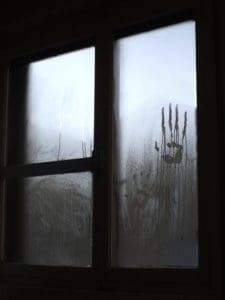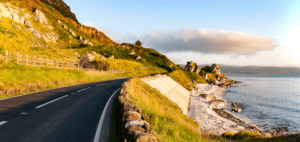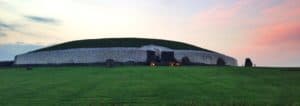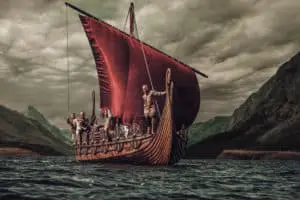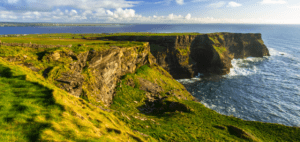Exploring Ireland’s Viking Legacy: 6 Fascinating Viking Sites in Ireland You Need To Visit At Least Once!
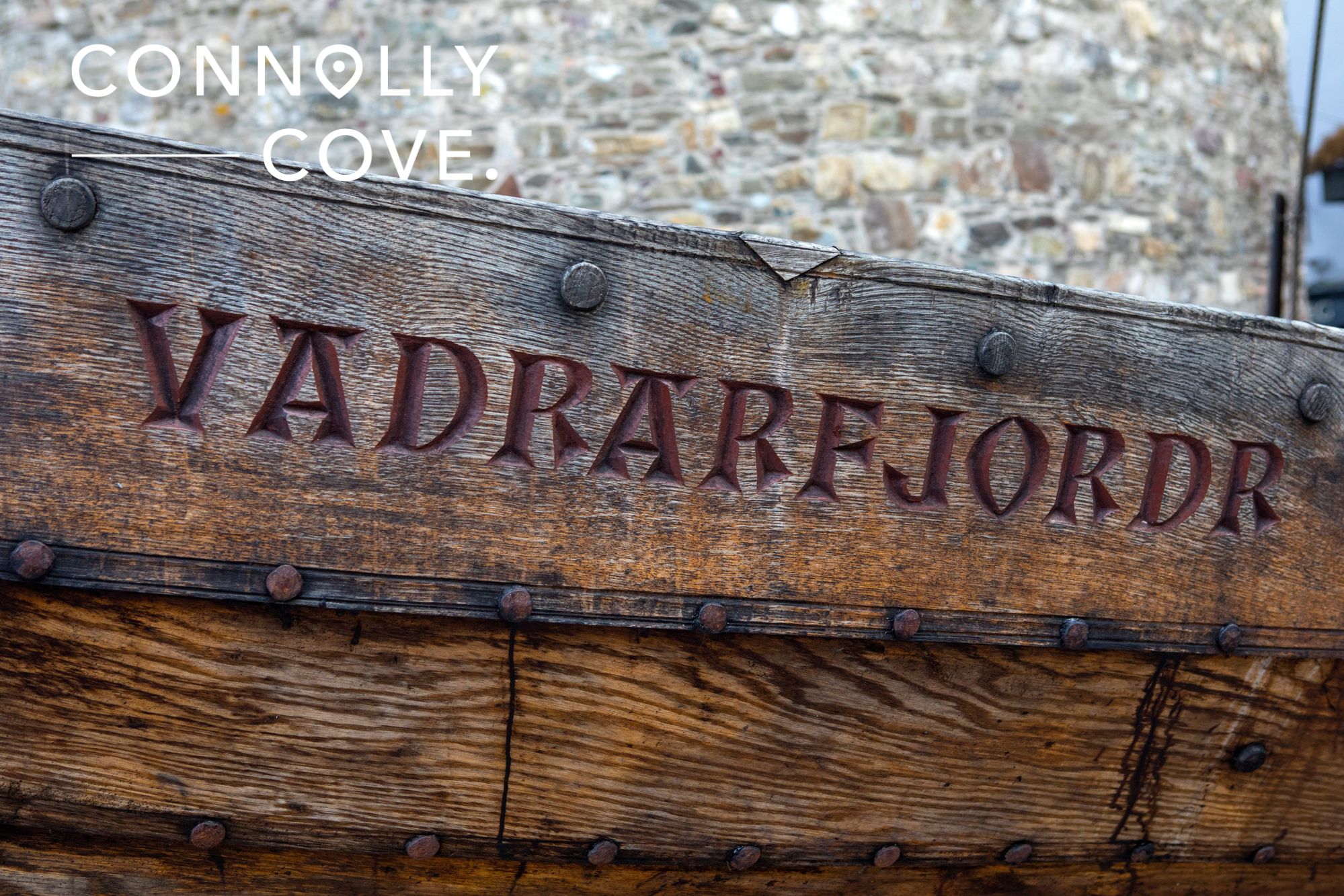
Updated On: April 24, 2024 by Esraa Mahmoud
Ireland, with its verdant landscapes and rich history, bears the imprints of various civilizations that once thrived on its soil. Among these, the Viking Age holds a significant place, marked by the arrival and settlement of Viking invaders who left an enduring impact on Ireland’s culture, trade, and societal evolution.
The remnants of their presence can be explored through various Viking sites in Ireland, each offering a glimpse into this fascinating chapter of Irish history. The Vikings left behind numerous exquisite Viking sites in Ireland, which you can visit today.
So, forget tourist traps and predictable pubs and let the echoes of the sea guide you to the Viking sites in Ireland. Walk through reconstructed houses, hear the clatter of workshops, and marvel at the everyday objects unearthed from centuries past.
Coming up next, we take a journey to a memorable period of time in Irish history, visiting the Viking sites in Ireland!
The Viking Chapter in The Irish History!
Around the 8th century, the Norsemen, aka the Vikings, driven by an insatiable hunger for plunder and exploration, began leaving their icy Scandinavian shores and setting their sights on Ireland’s fertile landscapes.
From the windswept shores of Dublin Bay to the bustling docks of Waterford, their impact on the island was as dramatic as it was enduring. They weren’t just ruthless raiders; they were traders, craftsmen, and eventually, reluctant neighbours, weaving themselves into the tapestry of Irish life, leaving behind a legacy that reverberates even today.
What are the Best Viking Sites in Ireland to Visit?
How do we truly grasp the scope of the Viking foray in Ireland? Where, in the rolling hills and bustling cities of modern Ireland, can we find the echoes of the Viking battle cries, the whispers of their sagas, the silent testament to their presence?
This is where the magic of archaeology takes centre stage. By delving into the earth, unearthing buried cities and forgotten treasures, we can begin to piece together the mosaic of the Viking sites in Ireland.
Dublinia
Dublinia is a historical recreation museum and visitor attraction in Dublin, focusing on the Viking and Medieval history of the city. There is so much you can enjoy at Dublinia; you will get to explore reconstructed Viking homes and workshops and witness the daily lives of early Dubliners through carefully recreated spaces featuring authentic tools, furniture, and even cooking pits.
You will meet living history actors and engage with costumed interpreters who bring the Viking and Medieval periods to life through demonstrations, storytelling, and interactive activities. You will also get up close and personal with artefacts unearthed from Dublin’s Viking and Medieval layers, including jewellery, weaponry, and everyday objects.
Among the highly recommended activities while there is to climb St. Michael’s Tower to enjoy the stunning panoramic views of Dublin. Dublinia is one of the best Viking sites in Ireland to learn about Viking and Medieval culture and where you get to delve into the fascinating history of these periods through exhibits, interactive displays, and multimedia presentations.
Christ Church Cathedral
Founded in 1030 by Sitric Silkbeard, a Viking king who embraced Christianity, Christ Church is a testament to the complex history of Dublin.
Its granite walls, built using Viking shipbuilding techniques, echo with the clang of hammers and the chatter of labourers who raised this monument to newfound faith. Inside, carved figures on the capitals hint at Norse influences, blending seamlessly with Christian motifs, a silent dialogue between two cultures finding common ground in stone.
Christ Church Cathedral witnessed the gradual integration of Viking culture into Christian society: Its Gothic architecture reflects a blending of Viking techniques and later European styles, symbolizing the evolution of Dublin’s cultural landscape.
Christ Church wasn’t just a physical space; it was a crucible where Viking traditions and Christian rituals danced a complex choreography. Norse festivals like Yuletide were reinterpreted as Christian celebrations, while Irish monks adopted Viking shipbuilding techniques to create their own religious barges. This cultural fusion isn’t just a relic of the past; it’s woven into the very fabric of Dublin’s identity, shaping its architecture, folklore, and even its spirit.
Irish National Heritage Park
Nestled on the banks of the River Slaney, just outside Wexford town, lies the Irish National Heritage Park. It’s not just a park; it’s a time machine, transporting visitors on a captivating journey through 9,000 years of Irish history. From the dawn of humankind to the arrival of the vikings, each step within its 35 acres unveils a captivating chapter in the island’s rich and vibrant past.
The Irish National Heritage Park offers a plethora of fascinating experiences, but at the top of the list of its attractions is definitely the Viking Village, where you can immerse yourself in the daily life of Vikings through reconstructed houses, workshops, a marketplace, and a longhouse. Witness craftsmen, traders, and children reenacting life from this era.
The National Heritage Park doesn’t shy away from the complexities of Viking history either. Visitors can learn about the intricate trade networks that stretched across Europe, the cultural exchange that birthed unique Hiberno-Norse traditions, and the inevitable conflicts that marked their presence.
You should also climb the imposing ramparts of this earthen fortification and imagine the fierce Viking warriors who once defended it. Learn about the strategic purpose and construction techniques of these ancient structures.
Beyond the reconstructed village and historical insights, the park offers a haven for nature lovers. Stroll through tranquil meadows bursting with wildflowers or follow winding paths through ancient woodland where gnarled trees stand sentinel-like silent guardians. Breathe in the fresh air, listen to the birdsong, and let the serenity of the Irish countryside wash over you.
As you meander through the reconstructed village, everyday Viking life unfolds before your eyes. Craftsmen hunched over looms weave intricate tapestries, their nimble fingers guided by age-old techniques. Merchants barter in a bustling marketplace, their voices rising in jovial haggling over trinkets and furs. Children, adorned with leather and beads, chase each other through wooden play structures, their laughter echoing through the air.
The National Heritage Park isn’t simply a charming reenactment. It delves deeper, offering a tangible understanding of Viking culture and its profound impact on Ireland. Explore the reconstructed longhouse, a communal dwelling housing entire families, and imagine the warmth and camaraderie it fostered.
National Museum of Ireland – Archaeology
Step across the threshold of the National Museum of Ireland – Archaeology and prepare to be transported to a time of clashing swords, whispered sagas, and daring voyages. While you might not find Viking longboats docked outside or warriors feasting within, within these hallowed halls lies a treasure trove of artefacts, whispers of a vibrant Viking past woven into the very fabric of the museum.
One of the museum’s crowning jewels is the Viking Ireland exhibition, a meticulously curated exploration of Dublinia, the ancient Viking city that laid the foundation for modern Dublin. Immerse yourself in reconstructed Viking houses, workshops, and bustling marketplaces, where the scent of wood smoke and the clatter of tools evoke the daily rhythms of life centuries ago.
Marvel at intricate carvings adorning weaponry, their blades whispering tales of fierce battles and daring expeditions. Touch fragments of everyday objects, from combs and gaming pieces to cooking utensils, feeling the tangible connection to generations long gone. Stand where mighty Viking warriors worshipped alongside Christian monks, their coexistence echoing in the stones of a reconstructed church.
But the Viking story doesn’t end within the Dublinia replica. Wander through the galleries and witness the spoils of countless archaeological excavations, each object a silent storyteller. Behold swords gleaming with a warrior’s spirit, their intricate patterns speaking of skilled craftsmanship. Examine delicate jewellery
While Dublinia paints a vivid picture of Viking life within the city walls, the museum’s collection extends far beyond. Discover evidence of Viking raids and trading networks across the island, from Waterford’s imposing Reginald’s Tower to the mystical Lough Neagh, a vast lake echoing with tales of Viking voyages.
Waterford
Where the River Suir kisses the Irish Sea, whispers of a legendary past dance on the salty breeze. This is Waterford, Ireland’s oldest city, its cobbled streets and towering landmarks echoing with the tales of fierce Vikings who carved their mark on this fertile land. But Waterford’s story is not just one of clashing axes and thunderous sagas; it’s a tapestry woven with threads of resilience, cultural fusion, and a spirit that shines as brightly today as it did a millennium ago.
Step back in time to the year 914 when Viking raiders, drawn by the river’s rich bounty and strategic location, established a settlement they called “Vadraford.” They build earthworks and timber defences, transforming the peaceful riverside into a bustling hub of trade and power. From their Long Quay on the Suir, Viking ships laden with furs, slaves, and precious metals set sail, establishing Waterford as a vital link in the Norse trading network.
The three sisters rivers, the Nore, the Barrow, and the Suir, that empty into Waterford Harbor, played a significant role in the Vikings’ decision to build a longphort (or dock) at the confluence of St. John’s River and the River Suir.
Delve into the Waterford Viking Triangle, a network of historical sites showcasing the city’s Norse heritage. Explore Reginald’s Tower, now a captivating museum, where interactive exhibits bring the Viking Age to life. Discover the Waterford Archaeological Museum, where unearthed treasures like intricately carved combs and weapons transport you to the hands that wielded them.
Waterford’s Viking story isn’t merely confined to museums and ancient stones. It pulsates in the city’s vibrant spirit. Witness the echoes of their adventurous spirit in the Waterford Harbor Festival, a lively celebration filled with Viking reenactments, traditional music, and a contagious joie de vivre. Taste the legacy in the city’s renowned black pudding, a Viking delicacy still savored today.
But Waterford’s saga is not solely about the past. The city has gracefully transformed into a cultural and economic hub, embracing its Viking heritage while forging its own modern path. Explore the Waterford Crystal factory, a global icon of craftsmanship, where skilled artisans continue a tradition once nurtured by Viking blacksmiths. Immerse yourself in the city’s thriving arts scene, where galleries and theatres showcase the creative spirit that both Vikings and the modern Waterford locals share.
Cork
While often overlooked in favour of more famous Viking sites in Ireland, such as Dublin, Cork has its own significant story to tell about Viking influence and settlement.
The Vikings began raiding the shores of Ireland around the 8th century, seeking riches and establishing strategic settlements. Cork, with its natural harbour and proximity to the River Lee, was an attractive location for these seafaring warriors. The river allowed easy access inland while providing a safe anchorage for their ships.
Historical records indicate that Cork was initially founded by the Vikings around the late 9th century, although the area was likely inhabited before their arrival. They named the settlement “Corcaigh,” derived from the Irish word for marshy place, which aptly described the terrain surrounding the area.
The Vikings’ impact on Cork was multifaceted. They constructed a series of fortifications and defences to protect their newly established settlement. One of the key structures was a fortification known as a longphort, a type of Viking defensive enclosure. This longphort served as a base for their activities and as a defensive outpost against potential adversaries.
Furthermore, the Vikings in Cork were not merely invaders; they were traders and craftsmen too. Their settlement served as a bustling hub for commerce, fostering trade networks that connected Cork to other Viking settlements across Europe. Archaeological findings in the area have unearthed artefacts such as coins, jewellery, pottery, and weaponry, offering insights into the daily life and economic activities of the Viking inhabitants.
The Viking presence in Cork was not without conflict. Historical accounts suggest clashes between the Norse settlers and the native Irish population. Over time, these interactions led to a blending of cultures and traditions, shaping the unique heritage of Cork.
The Viking influence on Cork’s development was significant and enduring. Despite their eventual integration and assimilation into Irish society, the legacy of the Norsemen remained in the city’s architecture, place names, and cultural practices.
Explore the ancient streets of Cork, and Viking whispers brush past you like ghosts. Wander down Shandon Street, named after the Norse word for “beautiful,” a reminder of the Viking appreciation for the city’s scenic charm. Stand beneath the mighty walls of Elizabeth Fort, built on the foundations of a Viking ringfort, a silent testament to their strategic prowess.
Within the Cork Public Museum, Viking treasures emerge from the shadows. Discover intricately carved combs, tools of everyday life whispering tales of skilled hands and quiet moments. Marvel at the Clonmacnoise Cross, a magnificent sculpture adorned with Viking knotwork and pagan symbols, a captivating blend of cultures.
Step out of the museum, and the Viking spirit pulsates in the very air. Cork’s love of storytelling, its boisterous festivals, and its laid-back charm – all echoes of the Viking spirit, their zest for life and embrace of adventure. Witness it in the lively shantys sung in traditional pubs, the boisterous laughter echoing Viking halls of yore. Experience it in the city’s annual Viking Fest, a vibrant celebration of their music, crafts, and warrior dances.
But Cork’s Viking legacy isn’t merely confined to historical sites and festivals. It’s woven into the city’s very name. “Corcach Mór” evolved into “Corcaigh,” later anglicized as Cork, a constant reminder of the Norse impact on the city’s identity. Even the famous Blarney Stone, a magnet for tourists seeking eloquence, sits atop a castle built by the Viking warlord Cormac Mac Carthy, another thread in the tapestry of this ancient city.
The Viking sites in Ireland stand as testaments to a period of dynamic cultural exchange and transformation. Museums, exhibitions, and archaeological excavations continue to uncover new insights into the lives of the Norse settlers and their interactions with the native Irish population. In essence, the Viking sites in Ireland serve as portals to a captivating era, inviting visitors to explore the convergence of Norse and Gaelic cultures and the enduring legacy left by these seafaring adventurers on the Emerald Isle.


